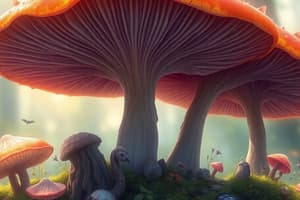Podcast
Questions and Answers
What is the primary way that fungi obtain their nutrients?
What is the primary way that fungi obtain their nutrients?
- Ingestion of food particles
- Extracellular digestion (correct)
- Absorbing nutrients through their cell membrane
- Photosynthesis
What is the main function of hyphae in fungi?
What is the main function of hyphae in fungi?
- To produce spores
- To absorb nutrients from the environment
- To form a network of fine filaments that make up the body of the fungus (correct)
- To provide structural support to the fungus
What is the purpose of a zygospore in fungi?
What is the purpose of a zygospore in fungi?
- To produce hyphae
- To produce spores through mitosis
- To facilitate asexual reproduction
- To protect the fungus from unfavourable conditions (correct)
What is the type of reproduction that fungi use in unfavourable conditions?
What is the type of reproduction that fungi use in unfavourable conditions?
What is the term for the branching network of hyphae that grow together underground?
What is the term for the branching network of hyphae that grow together underground?
Which of the following is an example of a fungus?
Which of the following is an example of a fungus?
How do fungi classify?
How do fungi classify?
What is the purpose of fungal spores?
What is the purpose of fungal spores?
What is the main component of the cell wall of fungi?
What is the main component of the cell wall of fungi?
Which of the following characteristics is NOT unique to fungi?
Which of the following characteristics is NOT unique to fungi?
What is the primary function of fungal enzymes?
What is the primary function of fungal enzymes?
What is the term for the process of fragmentation in fungi?
What is the term for the process of fragmentation in fungi?
Which type of fungi is characterized by the production of zygospores?
Which type of fungi is characterized by the production of zygospores?
What is the purpose of the thick spore wall in zygospores?
What is the purpose of the thick spore wall in zygospores?
What is the current method used to classify fungi?
What is the current method used to classify fungi?
Which type of fungi is characterized by the absence of a sexual phase?
Which type of fungi is characterized by the absence of a sexual phase?
Flashcards are hidden until you start studying
Study Notes
Fungi Characteristics
- Cell wall made of chitin
- Eukaryotic
- Mostly multicellular, except for yeast which is unicellular
- Classified by how they reproduce
- Heterotrophs, obtaining nutrients by extracellular digestion
Fungi Structure
- Multicellular, composed of two main parts:
- Hyphae: fine filaments that make up the body of the fungi
- Mycelium: a branching network of hyphae growing together underground
Reproduction
- Most fungi alternate between sexual and asexual reproduction
- Two types of asexual reproduction:
- Spores: windblown reproductive cells produced by mitosis
- Fragmentation: pieces of hyphae break off and grow into new mycelia
- Sexual reproduction: used in unfavorable conditions, produces genetically diverse spores
- Sexual spore formation: two haploid hyphae of opposite types combine to form a diploid zygospore
Fungi Classification
- Four major groups of fungi, separated by reproductive factors:
- Zygomycota (bread mould)
- Basidiomycota (mushrooms)
- Ascomycota (truffles, powdery mildew, single-celled yeast)
- Imperfect fungi (cheese moulds, penicillin mould)
Fungi Functions
- Single most important function: helping to recycle nutrients
- Decomposers in the carbon and nitrogen cycles
Fungi Characteristics
- Cell wall made of chitin
- Eukaryotic
- Mostly multicellular, except for yeast which is unicellular
- Classified by how they reproduce
- Heterotrophs, obtaining nutrients by extracellular digestion
Fungi Structure
- Multicellular, composed of two main parts:
- Hyphae: fine filaments that make up the body of the fungi
- Mycelium: a branching network of hyphae growing together underground
Reproduction
- Most fungi alternate between sexual and asexual reproduction
- Two types of asexual reproduction:
- Spores: windblown reproductive cells produced by mitosis
- Fragmentation: pieces of hyphae break off and grow into new mycelia
- Sexual reproduction: used in unfavorable conditions, produces genetically diverse spores
- Sexual spore formation: two haploid hyphae of opposite types combine to form a diploid zygospore
Fungi Classification
- Four major groups of fungi, separated by reproductive factors:
- Zygomycota (bread mould)
- Basidiomycota (mushrooms)
- Ascomycota (truffles, powdery mildew, single-celled yeast)
- Imperfect fungi (cheese moulds, penicillin mould)
Fungi Functions
- Single most important function: helping to recycle nutrients
- Decomposers in the carbon and nitrogen cycles
Studying That Suits You
Use AI to generate personalized quizzes and flashcards to suit your learning preferences.




